Deer Feeder Buying Guide
We know that we can improve the land we hunt by enhancing native vegetation, planting seasonal crops, and providing cover for deer to escape from predators. Many have also learned that furnishing additional nutrients using a deer feeder is an excellent tool to fine-tune deer nutrition and activity. Whether it’s providing supplemental protein for herd health or more attractive feed like corn to aid your hunting strategy, a deer feeder is a tool that comes in many shapes, sizes, and designs. In this article, we’re going to take a look at the various styles of deer feeders on the market today, and help you determine which one is best for your feeding goals.
The Best Deer Feeders In 2023
In the ever-evolving world of wildlife management and hunting, choosing the right deer feeder has never been more crucial. As 2023 unfolds, technology, design, and innovation merge to offer a plethora of choices tailored to specific needs and environments. Whether you’re prioritizing ease of use, durability against the elements, or protection from pesky intruders like bears, there’s a feeder on this list to match your requirements. In this comprehensive guide, we delve into the top-performing deer feeders across different categories, ensuring that you’re equipped with the knowledge to make the best decision for your deer management goals. Join us as we explore everything from automatic dispensers to protein-rich feeders that promise optimal nutrition for your local deer population.
Automatic Deer Feeders
Capsule Game Feeders Hunting Game Feeder
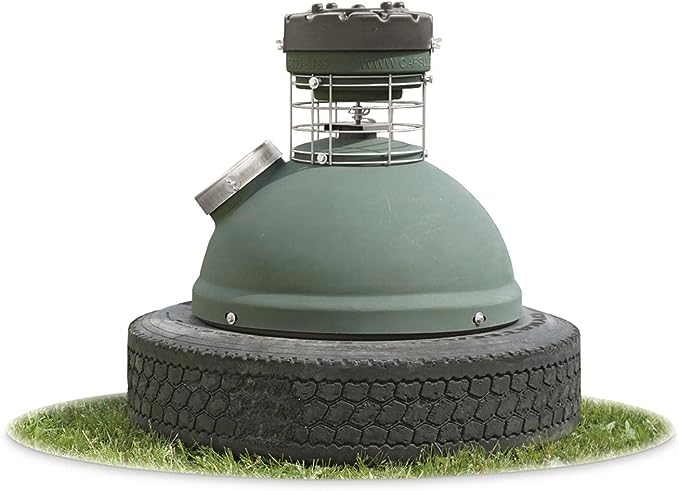
Features
- Ground-sitting capsule design offers safe filling
- HDPE structure is easily moveable, lightweight, and virtually indestructible
- Low center of gravity allows the feeder to rest safely
- Included digital timer provides up to 6 automated feedings a day
- Sit-and-fill design allows outdoor enthusiasts of any age to fill and operate the feeder
- Included solar panel keeps the battery charged all year round
Texas Hunter Stand and Fill 300 lb. Trophy Deer Feeder

Features
- 300 lb. Stand & Fill Deer Feeder
- 4 ft. Heavy Duty Extension Legs, Footpads and Stabilizing Stakes
- EZ Set Digital Timer
- 12 Volt Rechargeable Battery Included
- Pre-wired for optional and recommended Solar Charger – Model SP12
- 100% Varmint Proof Guard – Provides complete feed protection
- Constructed from Galvanized steel with a Powder-Coated finish
- Premium 12 Volt High Torque Motor
- Built-in Sight Glass for easy feed level reference
- Lockable compartment to store and protect Battery and Timer
- Stainless Steel Spinner Plate with built-in gate stops that help prevent wind from turning
Automatic deer feeders have risen in popularity due to their ease of use and advanced technology. But like all products, they come with their own set of advantages and disadvantages. One of the most significant advantages of automatic feeders is that they release feed at precise intervals. This consistent feeding schedule can help in patterning deer, making them accustomed to visiting the feeder at specific times. Many automatic feeders allow users to adjust the amount of feed dispensed. This can help in reducing waste and reducing the frequency of trips you need to fill your feeder up. By minimizing the frequency of visits to the feeder location, the deer are less likely to associate the food source with human presence, which can be particularly advantageous for hunting.
With any device that relies on mechanics and electronics, there’s the potential for malfunctions. A feeder that doesn’t dispense feed as scheduled can disrupt the pattern of deer and potentially waste stored feed. If not solar-powered, these feeders will require battery replacements or recharging, which can become a recurring expense and maintenance task. Automatic deer feeders are generally more expensive than their gravity-fed or manual counterparts. If not designed with pest-resistant features, these feeders can become a target for raccoons, squirrels, and other critters, leading to potential damage or feed loss. While many appreciate the features of an automatic feeder, they can be more complex to set up and operate than simpler feeder types. This can be a deterrent for those who prefer straightforward, low-tech solutions.
Hanging Deer Feeder
Texas Hunter EZ Lift Tripod Wildlife and Deer Feeder
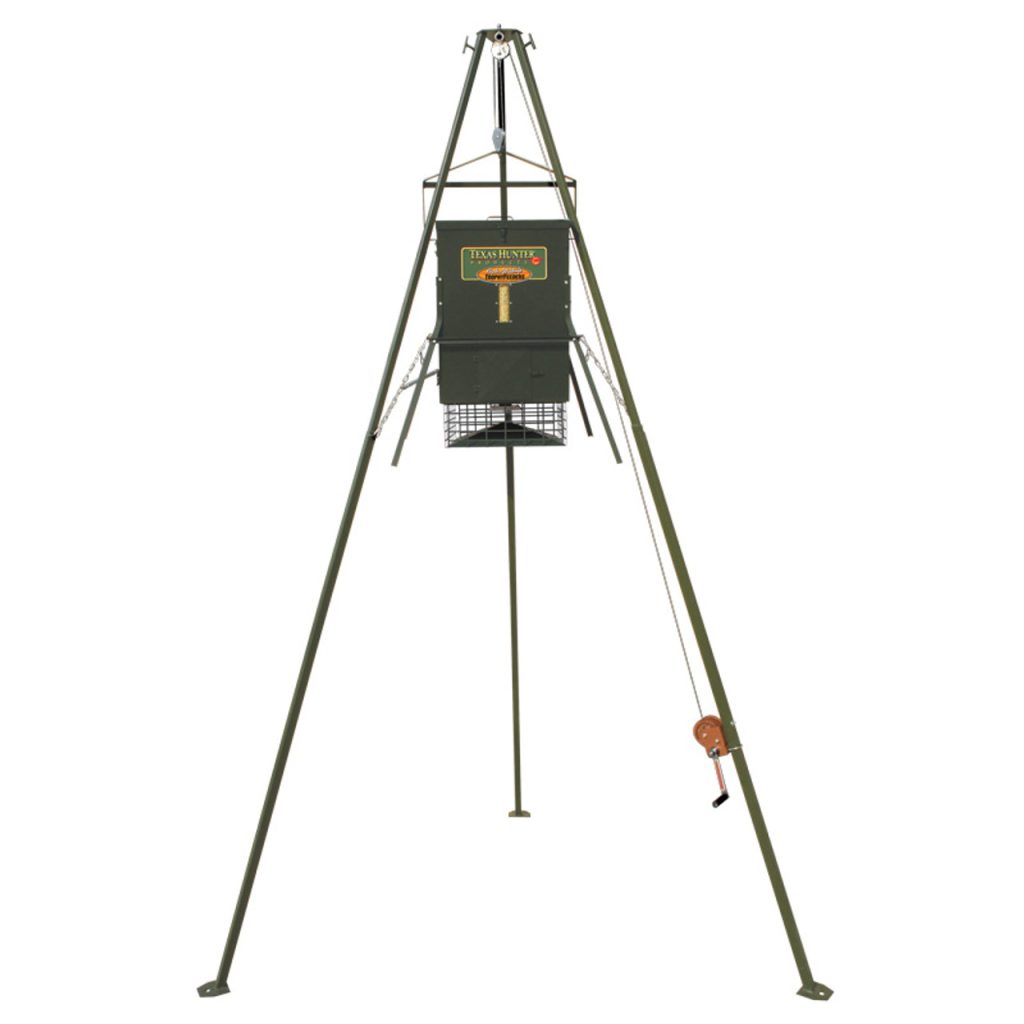
Features
- TF300 Trophy Deer Feeder with 300 lb. Corn Capacity
- Complete EZ Lift Tripod System
- EZ Set Digital Timer – Feeds 1 to 9 times per day – Run Time 1 to 60 seconds – Test Run 1 to 60 seconds.
- 12 Volt Solar Charger Included
- 100% Varmint Proof Guard Included
- Automatic Brake Winch with New Double Pulley
- Large Footpads with 24” Stabilizing Stakes.
- Heavy-Duty 2 piece Legs for easy shipping, set-up and portability.
- Overall Height 14’
- Stabilizing Chains Included
- Heavy-Duty Header for long lasting support
- 35’ High Strength Cable rated at 1,000 lbs
Moultrie Pro Hunter II Hanging Feeder
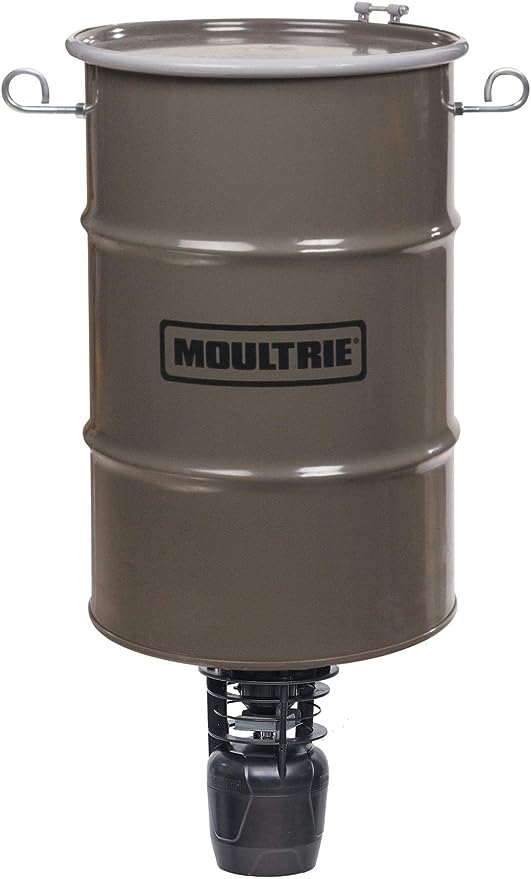
Features
- 30-gallon metal barrel holds up to 200 pounds of corn
- Metal spin plate
- Adjustable internal funnel
- ABS plastic housing
- Feed-level estimator
- Battery indicator
- External power port
- Digital timer programs up to 10 feed times per day, 1 to 60 seconds long
- Quick-Lock adapter mounts to any barrel or hopper
- One (1) 6V 5ah battery required (sold separately)
Moultrie 5-Gallon All-In-One Hanging Deer Feeder
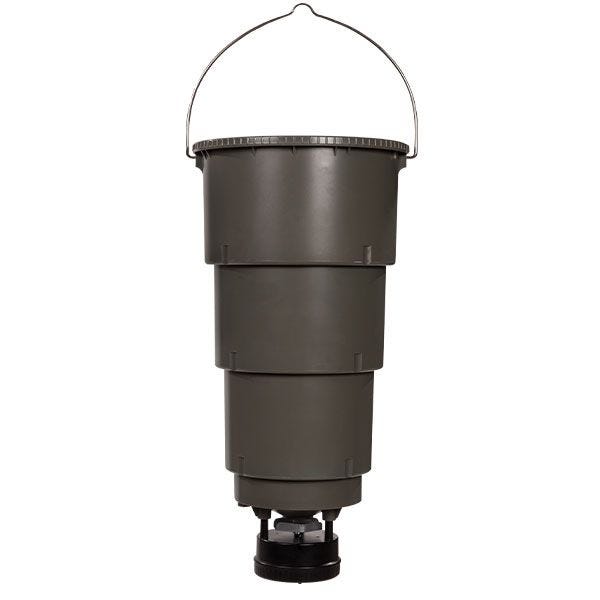
Features
- Digital timer programs up to 4 feed times per day, 1 to 20 seconds each
- 5-gallon collapsible plastic bucket, wind-resistant metal spin plate, built-in funnel
- Solar panel connectors (solar panel sold separately)
- Four (4) AA batteries (sold separately)
- No assembly required
Texas Hunter 100lb Capacity Hanging Wildlife Feeder
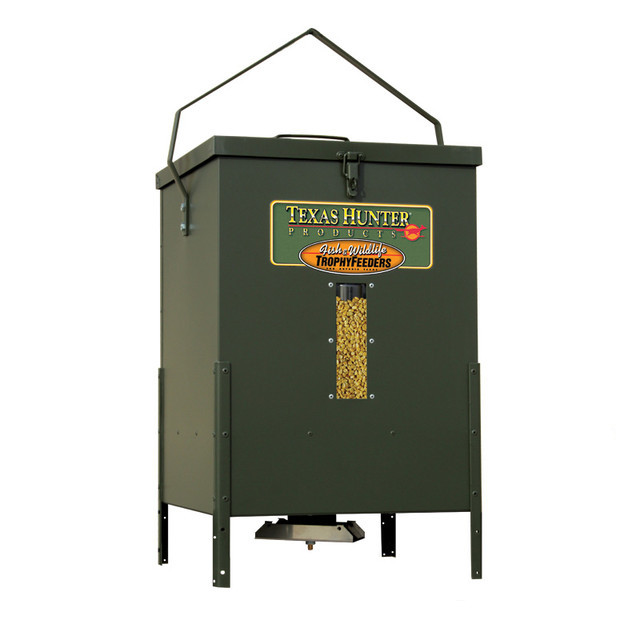
Features
- 100 lb. Corn Capacity
- Includes EZ Set Digital Timer
- Hanging bracket included
- Removable Baffles – All 4 Sides
- Pre-drilled for easy mounting of optional SP12 Solar Charger
- 12 Volt Rechargeable Battery Included
- Built-in Galvanized Funnel
- Premium 12 Volt High Torque Motor
- Built-in Sight Glass for easy feed level reference
- Constructed from Galvanized steel with a Powder-Coated finish
- Stainless Steel Spinner Plate with swinging gates and built-in gate stops
Moultrie Hanging Feeder Hoist
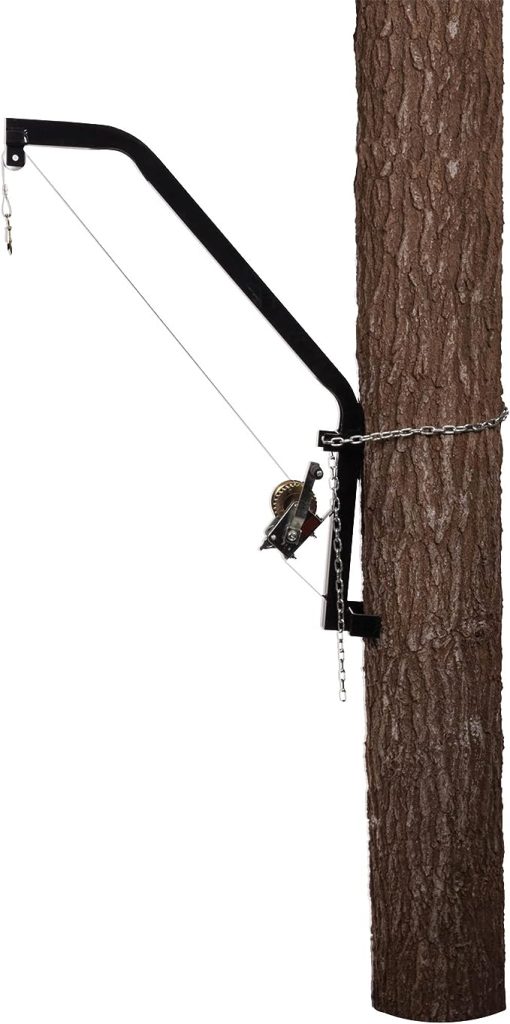
Features
- Suitable for hoisting feeders, game or heavy loads
- Attaches easily to any tree or pole
- 300 lb. capacity
- Chain-and-bracket design for easy installation and secure hoisting
- Manual winch and machined pulleys included
Hanging deer feeders, as the name suggests, are suspended above the ground, typically from tree branches or specially designed structures. One of the primary benefits of hanging deer feeders is that they are more challenging for pests like raccoons, squirrels, and rats to access compared to ground-based feeders. They can be hung at various heights and locations, making them adaptable to different terrains and environments. Hanging feeders are often lightweight and easy to transport, making them suitable for hunters or land managers who might want to shift feeding locations. Elevating the feed can sometimes reduce aggressive competition between deer, as the setup may not allow for many deer to feed simultaneously.
Hanging deer feeders generally have smaller capacities than some stationary, ground-based models. This means they may require more frequent refilling. Finding a suitable and sturdy branch or structure to hang the feeder can be challenging. Additionally, adjusting the height or relocating the feeder can be more labor-intensive compared to simply placing a feeder on the ground. If hung from tree branches, the weight of the feeder, especially when full, might cause damage or stress to the branch over time. Filling the feeder requires lifting feed overhead or using a ladder, which can pose safety risks, especially on uneven terrain or in inclement weather. If you don’t want to do this, an elaborate winch system may need be employed, which reduces the portability of the feeder, one of the main advantages.
Gravity Deer Feeder / Deer Protein Feeder
Moultrie Feed Station II

Features
- Holds 50-pounds of corn
- Dual feed ports with integrated rain shields and weep holes
- Easily straps to tree or post
- Perfect for feeding corn, protein pellets, rice bran and more
- No batteries needed
Banks Outdoors Feedbank 300 lb. Capacity Deer Feeder
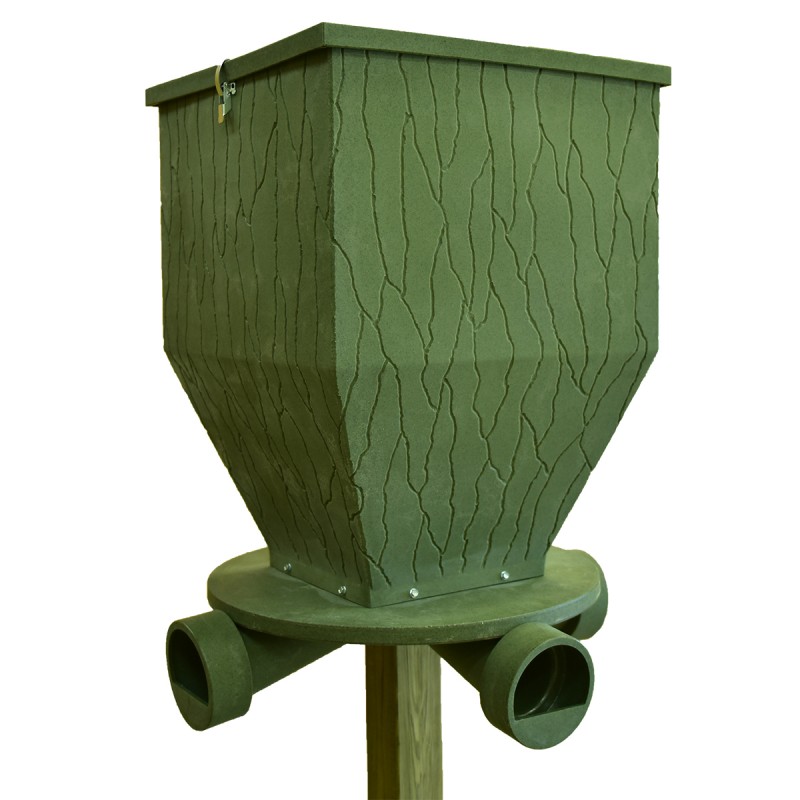
Features
- Design allows for 300 lbs of feed
- Mounts on one 8-foot 4×4 (not included) set 3-feet into the ground
- Single post won’t interfere with or damage antler growth
- Large, watertight cover makes filling easy and keeps feed fresh
- Feed ports stand at an optimal height of 42-inches
Texas Hunter 2000lb. Xtreme Protein Feeder
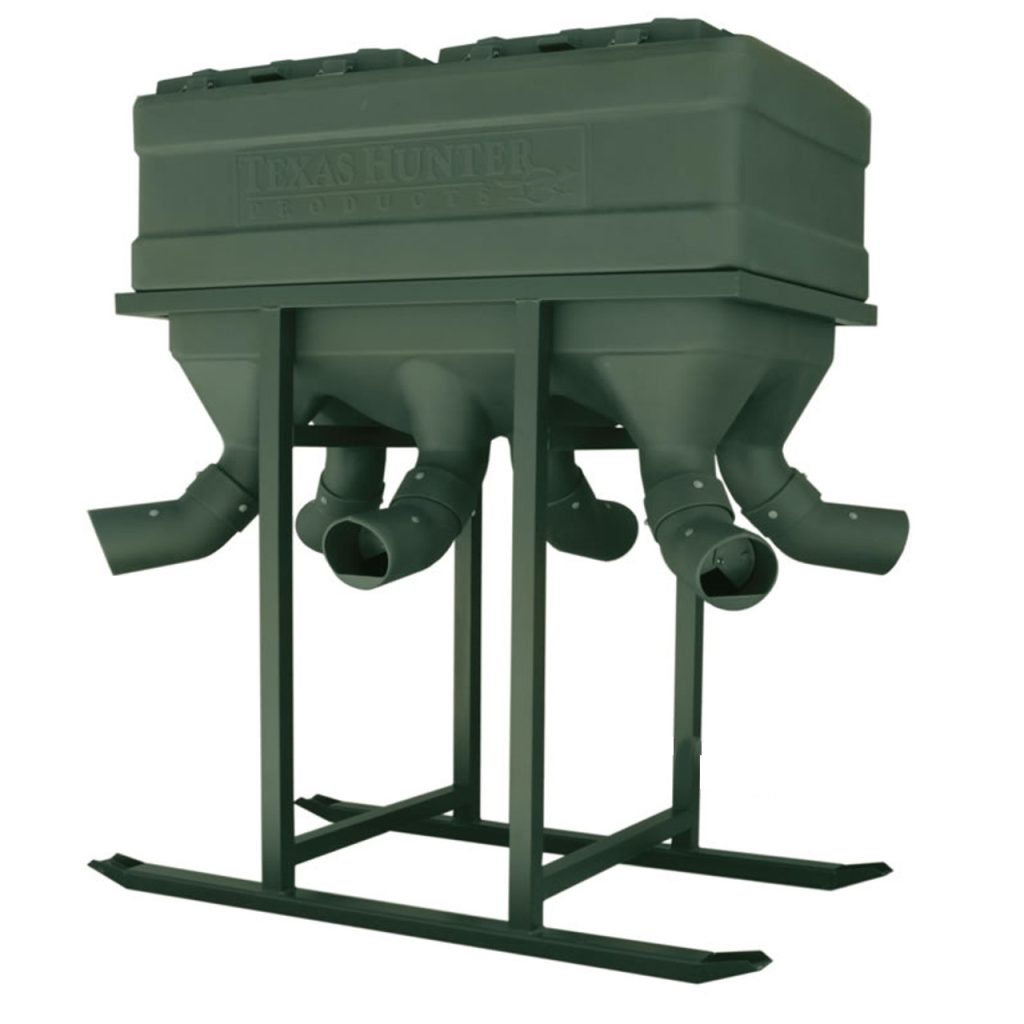
Features
- Major Innovation – Roto-Molded
- 26% Cooler than Steel
- Large 6″ Feed Ports
- Easy to Set-up, Fill and Move
- Stainless Steel Hardware.
- Six Protein Feed Stations
- Two Heavy-Duty Hinged Lids with Built-In Lid Stops for Easy Filling
- Food-Grade Material – Won’t Contaminate Protein or other Feeds
- Advanced Feed Flow – Contour Design Provides Continuous Flow
- Heavy-Duty, Powder-Coated Steel Stand with Skids for portability
Gravity deer feeders operate on a simple principle: feed is stored in a container and, as deer consume the feed from an opening or tray at the bottom, more feed is naturally dispensed by the force of gravity. They offer a hands-off approach to deer feeding, but come with their own set of strengths and weaknesses. With no electronic or moving parts, gravity feeders are less likely to break down or malfunction compared to more complicated feed systems. As long as there’s feed in the container, deer have access to it. This means deer can feed according to their preferences, which can be good and bad depending on your goals. For feeding protein, you may like for your deer to have as much as they want, while for feeding bait, you might want your feeder to have timed portions to reduce frequent filling and create a daytime pattern of use. Once set up and filled, gravity feeders can function for an extended period without the need for human interaction, reducing disturbance in the feeding area. Many gravity feeders are designed to protect feed from rain and other elements, keeping it dry and fresh. Without the need for batteries or solar panels, gravity feeders are often more cost-effective in the long run.
The continuous feed access can attract pests like raccoons, squirrels, and even birds, which can quickly deplete the feed intended for deer. Unlike automatic feeders that can be programmed to dispense specific amounts at certain times, gravity feeders do not offer this level of control. In areas with high deer densities, dominant individuals might monopolize the feeder, preventing others from accessing it. Depending on the design and capacity, some gravity feeders can be bulky or heavy, making installation and relocation more challenging. Gravity deer feeders are a durable and consistent option for those seeking a low-maintenance feeding solution. The choice of a gravity feeder should be made in the context of the local deer population’s needs and behaviors, as well as the specific objectives of the feeding program.
Bear Proof Deer Feeder
One and Done PRO Game Feeder
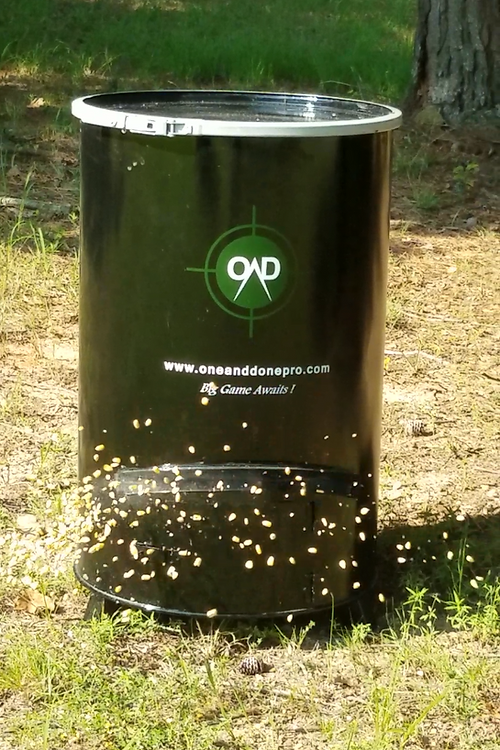
Features
- No assembly or tools necessary.
- Multiple patented directional feeder allows for the most accurate throw and calculation of how long feed will last
- 55-gallon capacity holds up to 250 lbs. High impact structure for hog resistance and bear proof
- Designed without plastic pieces that can be chewed on by rodents
- Includes Smart Program TM digital timer; schedule up to 6 feedings a day
- Customizable feed dispense time between 1-60 seconds
- One cup of feed covers the widest field range in the industry which helps manage feed to save you time and money
- Pair it up with our OAD rechargeable battery! Recommended recharge every 3-4 months. No need for solar panels
- Setup anywhere by ANYONE. The OAD feeder can be placed on the ground, strapped to a tree (bracket included), or on a traditional tripod
Deer hunters in Florida have been dealing with bears and deer feeder interactions for decades. This booklet put out by the FWC shows the many options available to you to “bear proof” your current feeder. See the hanging deer feeder options above as possible solutions to your bear and feeder problems.
Deer Block Feeder
Capsule Block Holder

Features
- Holds (1) Attractant Block up to 25 lbs
- Mounts to any tree or post
- Two Cam-Buckle straps included
- Made in the USA
EZ Outdoors EZ Block Feeder
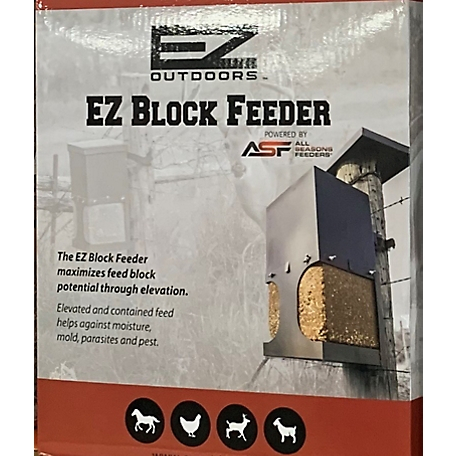
Features
- Block feeder holds any block from feed to attractant blocks
- Block feeder is great for deer
- Block feeder maximizes feed block potential through elevation
- Holds any 9 in.x9 in. feed or mineral block
Deer block feeders are designed to hold and gradually dispense compressed blocks of nutrition, often formulated with a mixture of grains, minerals, and other attractants. These feed blocks erode over time as deer lick or nibble at them. Given that deer blocks are dense and compressed, they tend to last a long time, reducing the need for frequent replenishments. Many deer blocks are specifically formulated to provide a balanced mix of nutrients, ensuring that deer receive essential vitamins and minerals. Many blocks incorporate scents and flavors, such as apple or acorn, which can effectively draw deer to the area. Once placed, the blocks require minimal attention until they’re fully consumed. Deer block feeders are often portable and can be placed in various terrains or habitats, making them adaptable to different environments.
While they last a while, the actual amount of feed a block provides is limited compared to bulk feeders. The blocks can erode or degrade more quickly in rainy or overly humid conditions, potentially leading to waste. Because of their attractive scents and flavors, feed blocks can draw pests such as raccoons, squirrels, and even birds. As with other types of feeders, dominant deer might monopolize access to a popular feed block, making it harder for more submissive deer to get their share.
Directional Deer Feeder
Texas Hunter Hide-A-Way Directional Wildlife Feeder
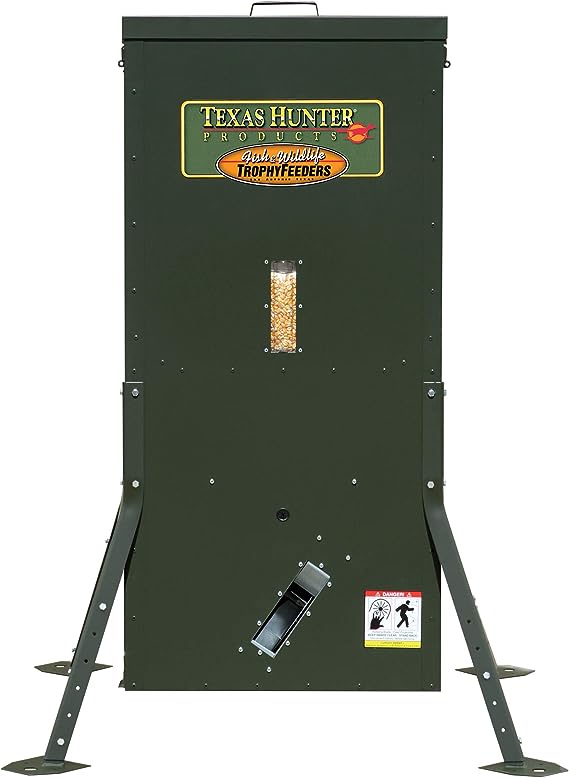
Features
- 300 lb. Corn Capacity
- Stand & Fill Design – Easy to Fill from the Ground
- Includes Texas Hunter’s Premium Digital Timer
- Feeds 1 to 9 times per day
- Run time 1 to 60 seconds
- Test Run 1 to 60 seconds
- Built-in battery tester
- 5-Year limited warranty
- 12 Volt Rechargeable Battery included
- Powder-coated Texas Hunter Green finish
- Powerful Centrifugal Air Blower System projects corn in a 30’ x 50’ wedge-shaped pattern
- Targeted Feed Placement. Place feed, deer and wildlife where you want
- 100% Varmint Proof
- Feed does not drop within 3-5 feet of the feeder, doesn’t attract varmints
- Lockable Lid and Access Door protects feed, timer & battery
- Two Feed Level Sight Glasses, check feed level from a distance
- Quick-release Access Panel with clear-view funnel allows instant viewing inside entire blower system
- Adjustable Legs with footpads and ground stakes
- Plus Shipping. Ships Anywhere via Motor Freight
- Built in America under US Utility Patent
One and Done PRO Game Feeder
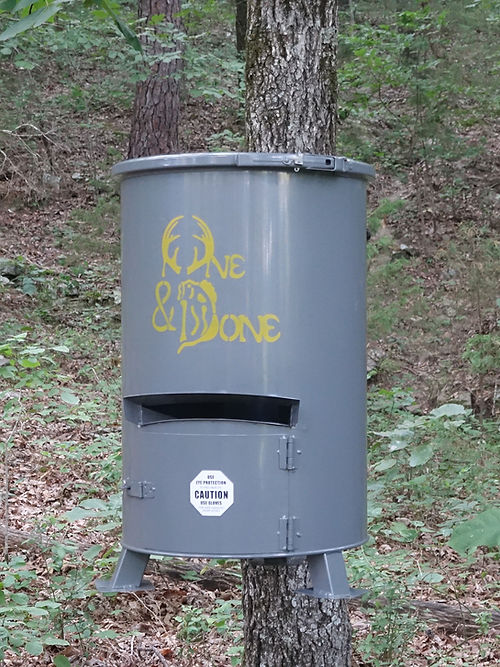
Features
- No assembly or tools necessary.
- Multiple patented directional feeder allows for the most accurate throw and calculation of how long feed will last.
- 30-gallon capacity holds up to 130 lbs. High impact structure for hog resistance and bear resistance.
- Designed without plastic pieces that can be chewed on by rodents.
- Includes Smart Program TM digital timer; schedule up to 6 feedings a day.
- Customizable feed dispense time between 1-60 seconds.
- One cup of feed covers the widest field range in the industry which helps manage feed to save you time and money.
- Pair it up with our OAD rechargeable battery! Recommended recharge every 3-4 months. No need for solar panels.
- Setup anywhere by ANYONE. The OAD feeder can be placed on the ground, strapped to a tree (bracket included), or on a traditional tripod.
- NOT recommended for areas with a heavy bear population and while this feeder is bear resistant, it is not bear proof like the 55 or 110 gallon models which are better suited in those areas.
- Upgraded backet and timer included.
Moultrie 6.5 Gallon Directional Hanging Feeder

Features
- Convenience of a hangable hopper makes it easy to place this feeder anywhere you need one
- Exclusive anti-clog technology makes this feeder a versatile and reliable choice
- Timer programmable for up to 10 daily feed times with dispense duration adjustable between 1-60 seconds
- Casts feed in narrow 30-degree path, perfect for along roads, trails, and into food plots
- Spinner plate design helps to prevents caking of feed and reduce clumps
Directional deer feeders are designed to cast feed in a specific direction or across a certain area, rather than dispensing it uniformly in all directions like many traditional broadcast feeders. The ability to direct feed towards a specific area allows users to focus on particular zones, such as clearings or trails, optimizing the use of the feed and potentially reducing waste. These feeders can be set up to distribute feed along a longer stretch of land or in a linear fashion, which can be useful for patterning deer movement or feeding multiple animals at once. By controlling where the feed lands, there’s less chance of it ending up in unwanted areas, such as water sources, roads, or overly dense vegetation. Because they don’t spread feed 360 degrees around the feeder, they can be placed closer to natural or man-made barriers without concern about feed waste. Many models allow users to adjust the width and distance of the spread, offering more customization based on specific needs.
The directional mechanism can add complexity to the feeder, potentially increasing the chances of mechanical failures or malfunctions over time. Many directional feeders rely on electronic mechanisms, meaning they may require batteries or other power sources, leading to potential maintenance and additional costs. Due to their specialized design and mechanism, directional feeders can be more expensive upfront than simpler feeder types.
Deer Feeder FAQs
What to feed deer?
Feeding deer year-round requires an understanding of their nutritional needs across different seasons. It’s essential to ensure that the feed not only attracts deer for hunting but also promotes their overall health and well-being. After winter, deer are in need of protein to help restore muscle and other tissues that may have been lost. Additionally, does are often pregnant during this time and require additional nutrients. Soybeans are excellent springtime choices as they are rich in protein. These help in antler growth for bucks and support does in their pregnancy. Summer is a growth period for deer. Bucks are developing antlers, and fawns are growing rapidly. Protein remains essential. Protein pellets can be a good supplement, especially in areas with less natural forage.
As the temperature drops in the Fall, deer require more energy to maintain body temperature. This is also the time when they’re preparing for the rut (mating season). They’ll need both protein for muscle maintenance and carbohydrates for energy. Corn is a popular choice in the fall due to its high carbohydrate content. However, it’s essential not to solely rely on corn. Mixing in protein-rich feeds, such high-quality deer pellets, ensures a balanced diet. For hunters, the fall is an optimal time to use food plots or feeders as attractants, as deer are actively foraging to build up reserves for winter.
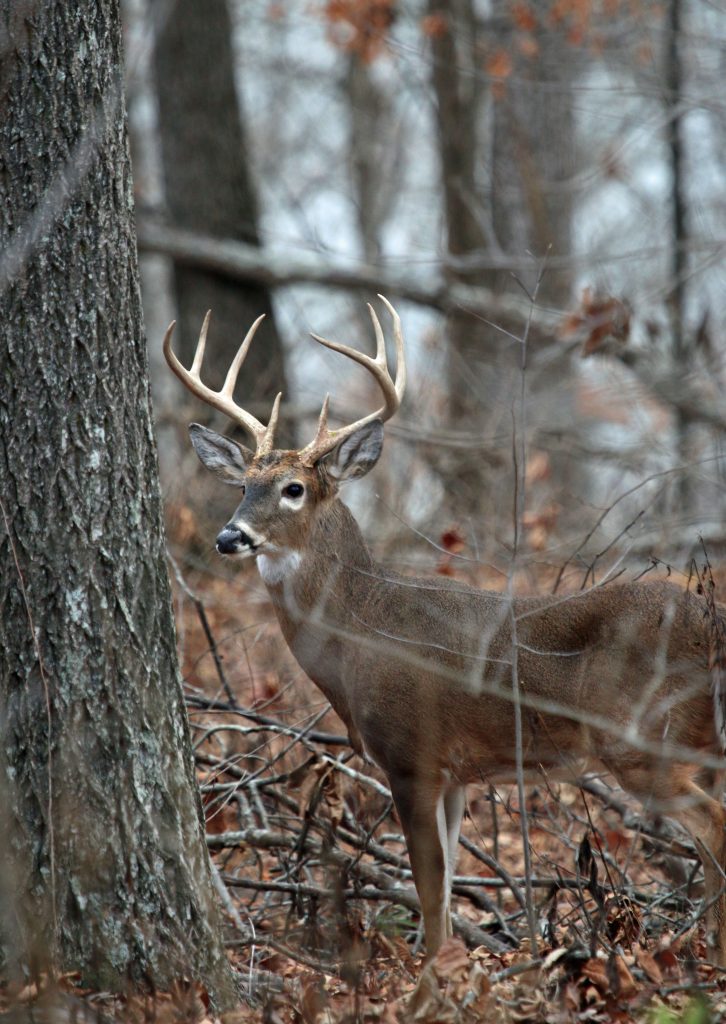
With harsh weather conditions, deer require foods that provide immediate energy. Their diet shifts towards carbohydrates, but they also need fats to help insulate and maintain body temperatures. While corn remains a popular choice, consider adding high-fat supplements like rice bran. Feeding deer year-round can be rewarding both for the health of the deer population and the success of hunting endeavors. However, always ensure that feeding practices align with local wildlife regulations and guidelines, and consider the long-term sustainability and impact on the deer population.
How high should a deer feeder be off the ground?
The height of a deer feeder off the ground is crucial for several reasons: to ensure that the targeted animals can comfortably access the feed, to minimize access by non-targeted animals or pests, and to reduce waste and spoilage. Adult deer, depending on the species, can stand anywhere from 6 to 8 feet tall when they stretch on their hind legs. However, for comfortable and natural feeding, you would ideally want the feeder’s dispensing mechanism or trough to be at a height of around 32 to 42 inches off the ground. This height is accessible for mature deer but also allows younger deer to feed without strain.
One of the primary reasons to elevate a feeder is to reduce access to feed by pests like raccoons and squirrels. While it’s difficult to make a feeder entirely pest-proof, elevating it and using cages or baffles can help. For raccoons, a height of 40 inches can deter many, but some clever raccoons might still find a way, especially if they can climb a nearby structure or jump from an overhanging tree limb. If you’re in an area with hogs or pigs, you might consider elevating the feeder even higher to prevent them from accessing the feed. In areas with bear activity, you might need specialized bear-proof feeders or even avoid feeding deer altogether to prevent habituating bears to human-provided food sources.
What is the best time to set a deer feeder?
Deer are crepuscular animals, which means they are most active during the twilight hours of dawn and dusk. Setting your feeder to dispense food during these times will align with their natural feeding patterns and minimize the amount of feed that reaches non target animals like birds, raccoons, pigs, etc.
Deer Feeder Final Thoughts
The “best” deer feeder is subjective. What’s best for a hunter can be completely different for another. That being said, pay close attention to the construction quality of your deer feeder as well as the manufacturers reputation for customer service after the sale. Deer feeders are exposed to harsh conditions and spending more up front for a higher quality build will assuredly pay off in the long run.
Full Disclosure: This post may include affiliate links. There’s no extra charge to our readers for using these.
